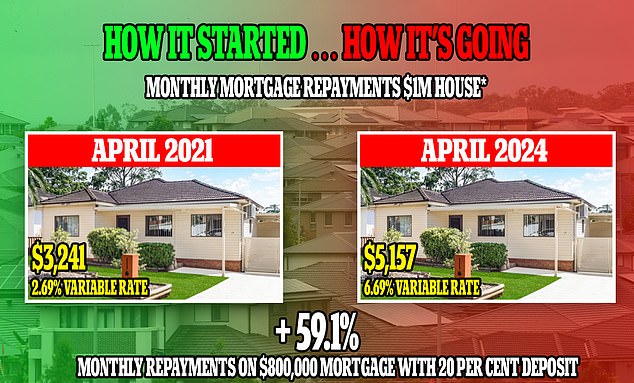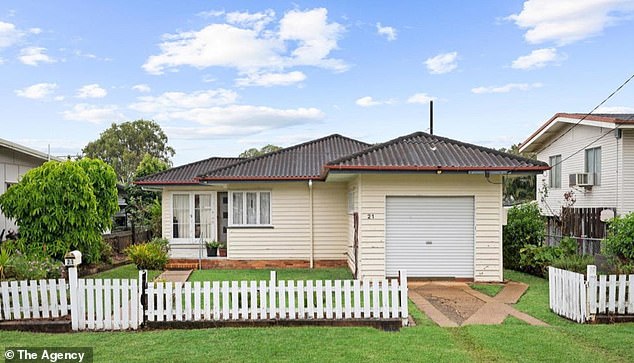Aussie mum exposes why she thinks a six-figure salary is no longer enough: ‘It feels crazy to say’
An Australian mother has sparked debate after claiming a six-figure income is not enough for a family of three to live ‘comfortably’.
Melbourne mother of a certain Lou, from That’s money momtold Daily Mail Australia her family had to adjust their spending habits as their mortgage payments doubled due to rising interest rates.
“Two years ago, my husband and I were making $150,000 a year,” she said.
“We had no kids, our mortgage was $800 and we could easily save $1,000 a fortnight without really trying.
“In the past two years, we’ve had a baby, I started working part-time, and our mortgage has increased by $800 a month.
“Our car insurance is up from $800 to $1,100, our legal entity is up $50 per quarter, Netflix is up, Spotify is up, and don’t even get me started on groceries.”
Lou added that the increased pressure on the budget meant her family had to ‘be frugal’.
“We count every dollar so we have a little bit left over to put on our mortgage,” she said.
“It feels crazy to say because $140,000 sounds like a huge amount of money, but for three people – two adults and a baby – with a mortgage in this economy, it just doesn’t feel like much at all.”
An Australian mother has sparked debate after claiming an income of $140,000 is not enough for a family of three to live ‘comfortably’ (stock image)

Australian borrowers are now paying 59 per cent more on their mortgage than three years ago – with financial markets now expecting even more interest rate rises in 2024
She defined comfort as the ability to enjoy a few luxuries without worrying about finances.
‘We are the lucky ones. “I think to feel comfortable you need to earn more, about $170,000, but that depends on your debt,” she said.
“We would be more comfortable without the mortgage.”
Hundreds of Australian mothers agreed, saying they were struggling with an income that would have given them the “high life” just a few years ago.
“I’m at $100,000. No children and difficulty finding the balance between saving and fun. $140,000 is definitely not a comfortable income for three or more people,” one person said.
Another wrote: “$140,000 is the new $80,000. My husband and I have a combined income of $200,000 with four children. We live on the tight side of comfortable.’
A third said: ‘Family of four. $260,000 income. We feel comfortable, but definitely not living the good life. five years ago we would have felt like royalty.”
Another said: ‘We’re at about $170,000 for a family of four and two pets and feel the same as when I was on maternity leave and making $100,000 five years ago.’
But others said $140,000 was more than enough to survive the cost-of-living crisis.
“I’m a single mother of three, and we live on $46,000 a year.”

For a borrower with an average mortgage of $600,000, monthly payments increased from $2,431 to $3,868, or by $17,244 per year
A second added: ‘We are a family of three on $150,000 a year and can easily save for holidays or renovations.
‘I think it depends on debt and mortgage. Makes a big difference. We have no car loans or debt, and our mortgage is $2,000 a month.”
A third said: ‘I’m a single mother on $55,000. But somehow I make it work. And I manage to save and my daughter has to go without anything.”
Australian borrowers are now paying 59 per cent more on their mortgage than three years ago – with financial markets now expecting even more interest rate rises in 2024.
In April 2021, the Commonwealth Bank, Australia’s largest housing provider, offered a variable mortgage rate of 2.69 percent.
But three years later, variable-rate borrowers are now paying 6.69 percent.
For a borrower with an average mortgage of €600,000, monthly repayments have increased from €2,431 to €3,868, or €17,244 per year.
Someone with an $800,000 mortgage – who would buy a $1 million home with a 20 percent down payment – would see their monthly repayments rise from $3,241 to $5,157.
That would amount to an increase in annual mortgage costs of $22,992.
And despite interest rate rises, house prices in Australia’s capitals have soared as immigration hit record highs – creating another hurdle for those struggling to buy a home.
The average house price in Sydney has risen by 10.7 per cent in the past year, but by 15.9 per cent in Brisbane and 20 per cent in Perth.
